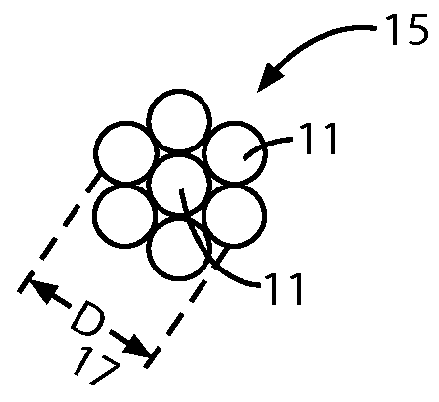NA reduction in fiber optical couplers
a technology of optical couplers and numeric apertures, applied in the field of optical couplers, can solve the problems of increasing the numerical aperture of light, difficult and less efficient coupling into other devices, and light rays emerging, so as to reduce the taper ratio, reduce the increase in na, and increase the overall performance
- Summary
- Abstract
- Description
- Claims
- Application Information
AI Technical Summary
Benefits of technology
Problems solved by technology
Method used
Image
Examples
experiment i
Thinner Fiber Claddings in the Second Section Configured by Etching Process
[0069]Multimode silica fibers with undoped cores and F-doped claddings were used in all cases described below. We compared the measured NA of an input fiber (105 μm core diameter, 125 μm cladding outside diameter, and 0.22 NA) to the output of a seven-fiber, multimode TFB of the type shown in FIGS. 1 and 2 but modified in accordance with this embodiment of our invention. The TFB was fabricated with a 10% TDR to reduce an initial diameter at interface 17 of 330 μm to a final diameter at interface 17 of 300 μm. Light was launched to fully-fill the NA of each fiber.
[0070]The NA of light in the 10% taper was measured to be approximately 0.02 larger than light in the input fiber (10% larger than the NA of the input fiber). This NA increase is consistent with that predicted by optical theory.
[0071]Since the NA increase of a TFB is due to light reflecting off of the core / cladding interface inside the tapered second ...
experiment ii
Thinner Fiber Claddings in Second Section Configured by Use of Thinner As-Drawn Fibers
[0076]Multimode silica fibers with undoped cores and F-doped claddings were used in all cases described below. A result similar to that of Experiment I was achieved by forming the second section of fibers that, as drawn, had smaller diameters than the fibers of first section, but the core diameters were the same (105 μm) in both sections. These separate sections were fusion spliced to one another to form a TFB of the type shown in FIGS. 1 and 2 but modified in accordance with this embodiment of our invention. The second section, and only this section, was then tapered by techniques well known in the TFB art.
[0077]All fibers of the second section had a 105 μm diameter core, but had different outside diameter claddings (116 μm, or 111 μm).
[0078]The NA results were comparable to those of Experiment I.
[0079]It is to be understood that the above-described arrangements are merely illustrative of the many...
PUM
 Login to View More
Login to View More Abstract
Description
Claims
Application Information
 Login to View More
Login to View More - R&D
- Intellectual Property
- Life Sciences
- Materials
- Tech Scout
- Unparalleled Data Quality
- Higher Quality Content
- 60% Fewer Hallucinations
Browse by: Latest US Patents, China's latest patents, Technical Efficacy Thesaurus, Application Domain, Technology Topic, Popular Technical Reports.
© 2025 PatSnap. All rights reserved.Legal|Privacy policy|Modern Slavery Act Transparency Statement|Sitemap|About US| Contact US: help@patsnap.com



